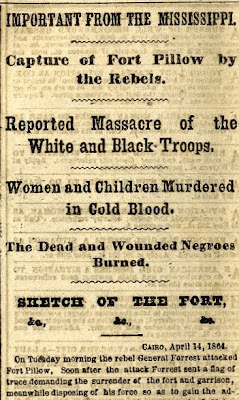


The Fort Pillow massacre was one of the worst blots on the record of Confederate troops during the American Civil War. Fort Pillow was located on the Tennessee bank of the Mississippi River and had fallen into Union hands in May 1862. However, even two years later, and with the main fighting now focused on the road to Atlanta, Confederate raiders still forced the Union to maintain garrisons across the occupied south. One of the best known of those raiders was General Nathan Bedford Forrest. He had been commanding the cavalry of the army in Tennessee but after the Confederate victory at Chickamauga in September 1864, he had fallen out with General Bragg and refused to serve under him any longer. While Bragg settled down to besiege Chattanooga, Forrest headed back to an independent command in Mississippi. In March 1864, Forrest took a division of cavalry (about 1,500 men) on a raid north through western Tennessee that actually reached as far north as Paducah, Kentucky. It was on his way back south that Forrest and his men committed what is now generally accepted as a massacre. Fort Pillow was garrisoned by one regiment of black troops, numbering 262, and a cavalry detachment of similar size, for a total of 557 men. On April 12, 1864, Forrest’s men attacked the fort. After a brief fight they overwhelmed the garrison. Confederate losses were fairly low (14 killed and 86 wounded). Union losses were much heavier. Of the garrison of 557 men, 231 were killed, 100 wounded and 226 captured. Only 75 of the 262 black troops were amongst the captured. The very high number of dead immediately attracted attention. The Federal commander of the fort, Major William Bradford, was conveniently killed "while attempting to escape". Despite southern denials at the time, it seems clear that several dozen black soldiers were killed after they had surrendered. Fort Pillow was the most visible outbreak of a Confederate fury at the very idea of black soldiers. The Fort Pillow massacre and a suitable response to it was the subject of some days debate in Lincoln’s cabinet. In the end, they could not find a response that would not risk escalating beyond control. Meanwhile, black soldiers continued to play a major, and increasing, role in the Union war effort, providing nearly 200,000 men to the northern war effort. After the war an official investigation discovered evidence that "the Confederates were guilty of atrocities which included murdering most of the garrison after it surrendered, burying Negro soldiers alive, and setting fire to tents containing Federal wounded." However, Nathan Bedford Forrest was never prosecuted for the offense and he went on to become the first Imperial Wizard of the Ku Klux Klan.
No comments:
Post a Comment